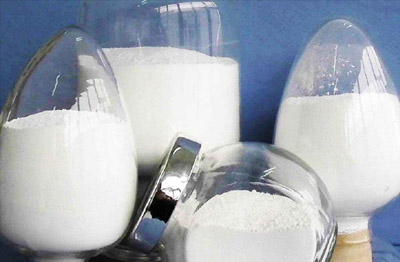
Inorganic compound with the chemical formula TiCl4. Titanium tetrachloride is an important intermediate in the manufacture of titanium and its compounds. At room temperature, titanium tetrachloride is a colorless liquid and fumes in air, forming a mixture of solid titanium dioxide and droplets of hydrochloric acid.
I. Basic Attributes
1. Introduction
Physicochemical constants of substances
GB No.: 81051
CAS No.: 7550 - 45 - 0
Product name:Titanium tetrachloride;Titanic chloride
Synonym: Titanium chloride
Molecular Formula: TiCl4
Appearance and Property: Colorless or slightly yellow liquid, with pungent sour taste. Fumes in the air
Molecular weight: 189.71
Vapor pressure: 1.33kPa(21.3℃)
Melting point: -25℃ Boiling point: 136.4℃
Solubility: soluble in cold water, ethanol and dilute hydrochloric acid
Density: Relative density (water =1)1.7260
Danger mark: 20(acid corrosive)
2. Preparation or Source
is prepare by blending titanium dioxide, carbon pow and starch and introducing chlorine gas at 600 DEG C.
3. Main Uses
Used for making titanium salt, iridescent agent, artificial pearl, smoke screen, pigment, fabric mordant, etc
4. Chemical properties
Stability: The chemical property is unstable, with irritant sour taste, white smoke will be emitted when meeting wet air, and TiCl4·5H2O will be formed firstly; Finally, it is hydrolyzed to form hydrated titanium dioxide (TiO2·xH2O). It absorbs dry ammonia to form TiCl4·4NH3 and TiCl4·6NH3. It reacts with alcohols to form titanium esters [such as Ti(OCnH2n+1)4]. It reacts with triethyl aluminum to form mixed halide-alkyl complexes with variable composition, which are famous Ziegler catalysts (important catalysts for isotactic polymerization of ethylene into high molecular weight solid polymers).
TiCl4 has a tetrahedral structure, with each Ti4+ ion bound to four Cl− ligands. Ti4+ ions have the same number of electrons as the noble gas argon, and are closed-shell structures. Thus, Titanium tetrachloride has a tetrahedral structure with a high degree of symmetry.
TiCl4 is soluble in nonpolar toluene and chlorinated hydrocarbons. Studies have shown that dissolution in some aromatic hydrocarbons involves the formation of complexes similar to [(C6R6)TiCl3]+. Titanium tetrachloride can react exothermically with Lewis base solvents such as THF to form six-coordinated adducts. For larger ligands, the product is five-coordinated TiCl4L.
In addition to releasing corrosive hydrogen chloride, storage of TiCl4 also produces titanium oxides and oxychlorides that stick to used stoppers and syringes.
5. Physical properties
Titanium tetrachloride is a colorless liquid with high density, and is often a yellow or reddish brown liquid when the sample is impure. Like vanadium tetrachloride, it is one of the few transition metal chlorides that are liquid at room temperature. Its low melting and boiling points are related to weak intermolecular forces. Most metal chlorides are polymers containing metal atoms connected by chlorine bridges, while titanium tetrachloride has a low melting and boiling point due to weak van der Waals forces.
II. Environmental impact
1. Health hazards
Route of invasion: Inhalation, ingestion.
Health hazards: direct contact with liquid Titanium tetrachloride may cause burns of different degrees. Its smoke and dust may have strong irritation to respiratory mucosa. Mild poisoning may cause asthmatic bronchitis, and severe poisoning may cause dyspnea, rapid respiratory pulse, elevated body temperature, cough, etc., and may develop into pulmonary edema.
2. Toxicological data and environmental behavior
Toxicity: highly toxic.
Acute toxicity: LC 50 400 mg/m3(rat inhalation)
Hazardous characteristics: heat or water decomposition heat, the emission of toxic corrosive smoke.
Combustion (decomposition) products: chlorides, titanium oxide.
3. Site emergency monitoring method:
4. Laboratory monitoring methods:
Titration (EPA Method 9252)
Gas chromatography, refer to Handbook of Analytical Chemistry (Volume IV, Chromatographic Analysis), Chemical Industry Press
5. Environmental standards:
Maximum allowable concentration of hazardous substances in the air of workplaces in the former Soviet Union 1mg/m3
III. Emergency treatment and disposal methods
1. Emergency treatment for leakage
Evacuate the personnel in the leakage pollution area to the safe area. Do not allow irrelevant personnel to enter the pollution area. It is recommended that the emergency response personnel wear positive pressure self-contained breathing apparatus and chemical protective clothing. Do not directly contact the leakage, and stop the leakage under the condition of ensuring safety. Spray water mist to slow down the volatilization (or spread), but do not spray water directly on the leakage or leakage point. Sprinkle soda ash on the ground, then flush with large amount of water, and put the diluted wash water into the waste water system. If there is a large amount of leakage, it is best to remove it without water treatment under the guidance of technicians.
2. Protective measures
Respiratory Protection: Wear a respirator when exposure to vapors is possible. Wear a respirator if necessary.
Eye protection: Wear chemical safety glasses.
Protective clothing: Wear work clothes (made of anti-corrosive materials).
Hand protection: Wear rubber gloves.
Others: After work, take shower and change clothes. Store clothes contaminated by poison separately and reuse them after washing. Keep good hygiene habits.
3. First aid measures
Skin contact: wipe off the poison with soft paper or cotton as soon as possible, and then rinse thoroughly with water. If you have burns, seek medical treatment.
Eye contact: Immediately lift eyelids and rinse with running water for 10 minutes or with 2% sodium bicarbonate solution. Seek medical attention.
Inhalation: Leave the site to fresh air. Keep the respiratory tract unobstructed. Give oxygen in case of dyspnea. Give aerosol inhalation of 2-4% sodium bicarbonate solution. See a doctor.
Ingestion: Rinse mouth immediately when patient is awake, give milk or egg white. Seek medical attention immediately.
Extinguishing method: dry powder, sandy soil. No water